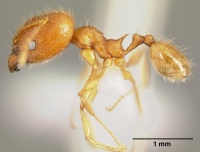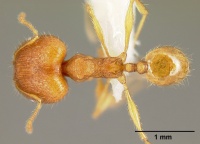Pheidole epiphyta
| Pheidole epiphyta | |
|---|---|

| |
| Scientific classification | |
| Kingdom: | Animalia |
| Phylum: | Arthropoda |
| Class: | Insecta |
| Order: | Hymenoptera |
| Family: | Formicidae |
| Subfamily: | Myrmicinae |
| Tribe: | Attini |
| Genus: | Pheidole |
| Species: | P. epiphyta |
| Binomial name | |
| Pheidole epiphyta Longino, 2009 | |
This species occurs in mid-elevation wet forest. It is known from one collection, a nest under epiphytes in a less than 1-month old treefall.
Identification
The morphometric profile of this species is unique. Minor worker: the combination of uniformly foveolate face and mesosoma, lack of promesonotal groove, very long posteriorly-directed propodeal spines, long scapes, and orange color is distinctive. Major worker: the combination of strongly cordate head, long scapes, uniformly foveolate sculpture over most of face, long propodeal spines, and orange color is distinctive. (Longino 2009)
Distribution
Latitudinal Distribution Pattern
Latitudinal Range: 10.3167° to 10.31667°.
| North Temperate |
North Subtropical |
Tropical | South Subtropical |
South Temperate |
- Source: AntMaps
Distribution based on Regional Taxon Lists
Neotropical Region: Costa Rica (type locality).
Distribution based on AntMaps
Distribution based on AntWeb specimens
Check data from AntWeb
Countries Occupied
| Number of countries occupied by this species based on AntWiki Regional Taxon Lists. In general, fewer countries occupied indicates a narrower range, while more countries indicates a more widespread species. |

|
Estimated Abundance
| Relative abundance based on number of AntMaps records per species (this species within the purple bar). Fewer records (to the left) indicates a less abundant/encountered species while more records (to the right) indicates more abundant/encountered species. |

|
Biology
Castes
Worker
Minor
Images from AntWeb
 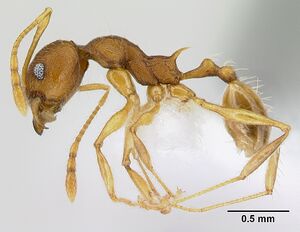  
| |
| Paratype Pheidole epiphyta. Worker. Specimen code casent0608921. Photographer Erin Prado, uploaded by California Academy of Sciences. | Owned by CAS. |
   
| |
| Paratype Pheidole epiphyta. Worker. Specimen code jtlc000005405. Photographer Stephanie Ware, uploaded by Field Museum. | Owned by FMNH. |
    
| |
| Paratype Pheidole epiphyta. Worker. Specimen code casent0608899. Photographer John T. Longino, uploaded by California Academy of Sciences. | Owned by USNM. |
Major
Images from AntWeb
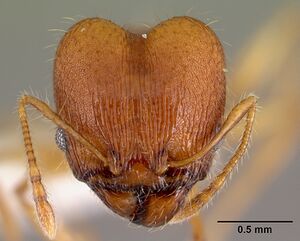 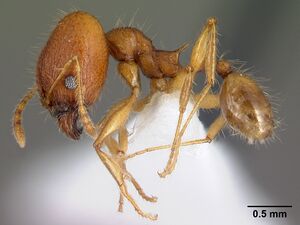  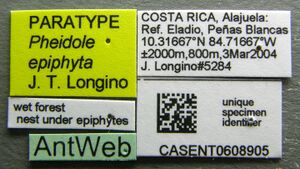
| |
| Paratype Pheidole epiphyta. Worker (major/soldier). Specimen code casent0608905. Photographer Erin Prado, uploaded by California Academy of Sciences. | Owned by CAS. |

| |
| Worker (major/soldier). Specimen code casent0608900. Photographer J. Longino, uploaded by University of Utah. | Owned by JTLC. |
Nomenclature
The following information is derived from Barry Bolton's Online Catalogue of the Ants of the World.
- epiphyta. Pheidole epiphyta Longino, 2009: 29, fig. 6 (s.w.) COSTA RICA.
Unless otherwise noted the text for the remainder of this section is reported from the publication that includes the original description.
Description
Worker
Minor Measurements (paratype): HL 0.65, HW 0.54, HLA 0.22, SL 0.71, EL 0.15, ML 0.82, PSL 0.12, PMG 0.00, SPL 0.04, PTW 0.11, PPW 0.14, CI 84, SI 130, PSLI 18, PMGI 0, SPLI 6, PPI 125.
Mandible and clypeus smooth and shining; face uniformly foveolate; margin of vertex rounded; occipital carina narrow, visible in full face view; scape with abundant erect setae longer than maximum width of scape; pronotal humerus weakly developed as obtuse prominence; promesonotal groove indistinct; propodeal spines present, large; entire mesosoma foveolate; abundant setae on promesonotal dorsum; dorsal (outer) margin of hind tibia with abundant suberect setae longer than maximum width of tibia; first gastral tergum smooth and shining; gastral dorsum with abundant erect setae; color orange.
Major Measurements (holotype): HL 1.17, HW 1.18, HLA 0.29, SL 0.72, EL 0.18, ML 0.97, PSL 0.23, PMG 0.00, SPL 0.05, PTW 0.17, PPW 0.24, IHT 0.21, OHT 0.40, CI 100, SI 61, PSLI 19, PMGI 0, SPLI 4, PPI 143, HTI 52.
Head cordate; mandible smooth and shiny; clypeus shining, smooth with weak median carina, 2-3 more prominent carinae anterior to frontal carinae, anterior margin straight but with small semicircular impression; face with longitudinal rugae between frontal carina and compound eye and between frontal carinae, rest of face foveolate; head with abundant suberect setae projecting from sides of head in face view; scape smooth and shining or minutely rugulose, terete at base, with abundant erect setae longer than maximum width of scape; hypostomal margin straight; a small blunt median tooth present; inner hypostomal teeth distinct, closer to midline than to outer hypostomal teeth; promesonotal groove indistinct; propodeal spines present, large; mesosoma largely foveolate; dorsal (outer) margin of hind tibia with abundant erect setae, some longer than maximum width of tibia; pilosity abundant on mesosomal dorsum; first gastral tergite smooth and shining, with abundant erect setae; color orange.
Type Material
Holotype major worker. Costa Rica, Alajuela: Casa Eladio, Rio Peñas Blancas, 10.31667°N 84.71667°W, ±2000m, 800m, 3 Mar 2004 (J. Longino#5284) Instituto Nacional de Biodiversidad, unique specimen identifier CASENT0608898.
Paratypes: major and minor workers. Same data as holotype The Natural History Museum, California Academy of Sciences, EAPZ, ECOSCE, Field Museum of Natural History, Instituto Nacional de Biodiversidad, John T. Longino Collection, Los Angeles County Museum of Natural History, Museum of Comparative Zoology, Musee d'Histoire Naturelle Genève, Instituto de Zoologia Agricola, Museu de Zoologia da Universidade de Sao Paulo, MEL, University of California, Davis, UNAM, ICN, National Museum of Natural History, UVGC.
Etymology
The name is in reference to the nesting habits of this species.
References
- Longino, J.T. 2009. Additions to the taxonomy of New World Pheidole. Zootaxa 2181: 1-90. PDF
References based on Global Ant Biodiversity Informatics
- Longino J. T. 2009. Additions to the taxonomy of New World Pheidole (Hymenoptera: Formicidae). Zootaxa 2181: 1-90.
